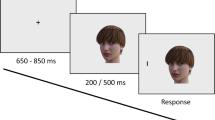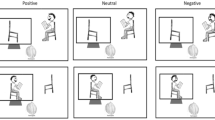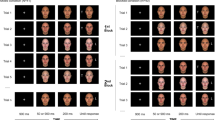Abstract
Social ostracism, a negative affective experience in interpersonal interactions, is thought to modulate the gaze-cueing effect (GCE). However, it is unclear whether the impact of social exclusion on the GCE is related to the identity of the cueing face. Therefore, the present study employed a two-phase paradigm to address this issue. In the first phase, two groups of participants were instructed to complete a Cyberball game with two virtual avatars to establish a binding relationship between a specific face’s identity and the emotions of social exclusion or inclusion. In the second phase, these two virtual avatars (exclusion faces/inclusion faces) and two new faces (control faces) were used as cueing faces in the gaze-cueing task. The results found that, for the exclusion group, the magnitudes of the GCEs for the exclusion and exclusion-control faces were similar in the 200 ms stimulus onset asynchrony (SOA) condition, while the exclusion face’s GCE was significantly smaller than that of the exclusion-control face in the 700 ms SOA condition. In contrast, for the inclusion group, the GCEs for inclusion and inclusion-control faces in both the 200 ms SOA and 700 ms SOA conditions did not significantly differ. This study reveals that the effect of social exclusion on the GCE is related to the identity of the cueing face, with individuals more reluctant to follow the gaze direction of excluder and shift their attention and provides experimental evidence that the perception of higher social relations can exert a top-down impact on the processing of social spatial cues.



Similar content being viewed by others
Data availability
The data of this study are available at https://data.mendeley.com/datasets//6kg3cccfc5.
References
Bayliss, A. P., Di Pellegrino, G., & Tipper, S. P. (2005). Sex differences in eye gaze and symbolic cueing of attention. The Quarterly Journal of Experimental Psychology Section A, 58(4), 631–650.
Bayliss, A. P., Paul, M. A., Cannon, P. R., & Tipper, S. P. (2006). Gaze cuing and affective judgments of objects: I like what you look at. Psychonomic Bulletin & Review, 13(6), 1061–1066.
Brooks, R., & Meltzoff, A. N. (2014). Gaze following: A mechanism for building social connections between infants and adults. In M. Mikulincer & P. R. Shaver (Eds.), Mechanisms of social connection: From brain to group (pp. 167–183). American Psychological Association. https://doi.org/10.1037/14250-010.
Buckley, K. E., Winkel, R. E., & Leary, M. R. (2004). Reactions to acceptance and rejection: Effects of level and sequence of relational evaluation. Journal of Experimental Social Psychology, 40(1), 14–28. https://doi.org/10.1016/S0022-1031(03)00064-7.
Capellini, R., Riva, P., Ricciardelli, P., & Sacchi, S. (2019). Turning away from averted gazes: The Effect of Social Exclusion on Gaze Cueing. Frontiers in Psychology, 10, 1000. https://doi.org/10.3389/fpsyg.2019.01000.
Capozzi, F., & Ristic, J. (2018). How attention gates social interactions. Annals of the New York Academy of Sciences. https://doi.org/10.1111/nyas.13854.
Carraro, L., Dalmaso, M., Castelli, L., & Galfano, G. (2015). The politics of attention contextualized: Gaze but not arrow cuing of attention is moderated by political temperament. Cognitive Processing, 16(3), 309–314. https://doi.org/10.1007/s10339-015-0661-5.
Cheal, M., & Lyon, D. R. (1991). Central and peripheral precuing of forced-choice discrimination. The Quarterly Journal of Experimental Psychology, 43(4), 859–880.
Chen, Y., Zhao, Y., Song, H., Guan, L., & Wu, X. (2017). The neural basis of intergroup threat effect on social attention. Scientific Reports, 7(1). https://doi.org/10.1038/srep41062.
Chester, D. S., Lynam, D. R., Milich, R., & DeWall, C. N. (2018). Neural mechanisms of the rejection–aggression link. Social Cognitive and Affective Neuroscience, 13(5), 501–512. https://doi.org/10.1093/scan/nsy025.
Ciardo, F., Ricciardelli, P., Lugli, L., Rubichi, S., & Iani, C. (2015). Eyes keep watch over you! Competition enhances joint attention in females. Acta Psychologica, 160, 170–177. https://doi.org/10.1016/j.actpsy.2015.07.013.
Corr, J. P. (2005). Social Exclusion and the Hierarchical Defense System: Comment on MacDonald and Leary (2005). Psychological Bulletin, 131(2), 231–236. https://doi.org/10.1037/0033-2909.131.2.231.
Dalmaso, M., Galfano, G., Coricelli, C., & Castelli, L. (2014). Temporal dynamics underlying the modulation of Social Status on Social attention. PLOS ONE, 9(3), e93139. https://doi.org/10.1371/journal.pone.0093139.
Dalmaso, M., Galfano, G., & Castelli, L. (2015). The impact of same- and other-race gaze distractors on the control of Saccadic Eye Movements. Perception, 44(8–9), 1020–1028. https://doi.org/10.1177/0301006615594936.
Dalmaso, M., Castelli, L., & Galfano, G. (2020). Social modulators of gaze-mediated orienting of attention: A review. Psychonomic Bulletin & Review, 27(5), 833–855. https://doi.org/10.3758/s13423-020-01730-x.
Dalmaso, M., Castelli, L., & Galfano, G. (2021). Increased gaze cueing of attention during COVID-19 lockdown. iScience, 24(11), 103283. https://doi.org/10.1016/j.isci.2021.103283.
Deaner, R. O., Shepherd, S. V., & Platt, M. L. (2007). Familiarity accentuates gaze cuing in women but not men. Biology Letters, 3(1), 65–68. https://doi.org/10.1098/rsbl.2006.0564.
Dewall, C. N., Schaller, M., Maner, J. K., & Baumeister, R. F. (2007). Does social exclusion motivate interpersonal reconnection? Resolving the ‘porcupine problem’. Journal of Personality & Social Psychology, 92(1), 42–55.
Dodd, M. D., Hibbing, J. R., & Smith, K. B. (2011). The politics of attention: Gaze-cuing effects are moderated by political temperament. Attention Perception & Psychophysics, 73(1), 24–29. https://doi.org/10.3758/s13414-010-0001-x.
Driver, J., Davis, G., Ricciardelli, P., Kidd, P., Maxwell, E., & Baron-Cohen, S. (1999). Gaze Perception triggers Reflexive Visuospatial Orienting. Visual Cognition, 6(5), 509–540. https://doi.org/10.1080/135062899394920.
Faul, F., Erdfelder, E., Lang, A. G., & Buchner, A. (2007). G*Power 3: A flexible statistical power analysis program for the social, behavioral, and biomedical sciences. Behavior Research Methods, 39(2), 175–191. https://doi.org/10.3758/BF03193146.
Friesen, C. K., & Kingstone, A. (1998). The eyes have it! Reflexive orienting is triggered by nonpredictive gaze. Psychonomic Bulletin & Review, 5(3), 490–495.
Friesen, C. K., Ristic, J., & Kingstone, A. (2004). Attentional effects of Counterpredictive Gaze and Arrow cues. Journal of Experimental Psychology: Human Perception and Performance, 30, 319–329.
Frischen, A., Bayliss, A. P., & Tipper, S. P. (2007). Gaze cueing of attention: Visual attention, social cognition, and individual differences. Psychological Bulletin, 133(4), 694–724. https://doi.org/10.1037/0033-2909.133.4.694.
Gabbiadini, A., & Riva, P. (2018). The lone gamer: Social exclusion predicts violent video game preferences and fuels aggressive inclinations in adolescent players. Aggressive Behavior, 44(2), 113–124. https://doi.org/10.1002/ab.21735.
Giesen, C. G., Nagel, L., Rudolph, M., & Rothermund, K. (2021). Smaller than expected: Effects of imitative action regulation after experiencing social exclusion. Experimental Psychology, 68(3), 137–148. https://doi.org/10.1027/1618-3169/a000516.
Gobbini, M. I., & Haxby, J. V. (2007). Neural systems for recognition of familiar faces. Neuropsychologia, 45(1), 32–41. https://doi.org/10.1016/j.neuropsychologia.2006.04.015.
Jeffreys, H. (1935). Some tests of significance, treated by the theory of probability. Mathematical Proceedings of the Cambridge Philosophical Society, 31(2), 203–222. https://doi.org/10.1017/S030500410001330X.
Jones, B. C., DeBruine, L. M., Main, J. C., Little, A. C., Welling, L. L. M., Feinberg, D. R., & Tiddeman, B. P. (2010). Facial cues of dominance modulate the short-term gaze-cuing effect in human observers. Proceedings of the Royal Society B: Biological Sciences, 277(1681), 617–624. https://doi.org/10.1098/rspb.2009.1575.
Jones, B. C., Main, J. C., Little, A. C., & DeBruine, L. M. (2011). Further evidence that facial cues of Dominance Modulate Gaze Cuing in Human observers. Swiss Journal of Psychology, 70(4), 193–197. https://doi.org/10.1024/1421-0185/a000056.
Lassalle, A. (2013). Modulation of Gaze-oriented Attention with Facial Expressions: ERP Correlates and Influence of Autistic Traits.
Lyyra, P., Wirth, J. H., & Hietanen, J. K. (2017). Are you looking my way? Ostracism widens the cone of gaze. Quarterly Journal of Experimental Psychology, 70(8), 1713–1721. https://doi.org/10.1080/17470218.2016.1204327.
Maner, J. K., DeWall, C. N., Baumeister, R. F., & Schaller, M. (2007). Does social exclusion motivate interpersonal reconnection? Resolving the ‘porcupine problem’. Journal of Personality and Social Psychology, 92(1), 42–55. https://doi.org/10.1037/0022-3514.92.1.42.
Martin, A. J., Nejad, H. G., Colmar, S., & Liem, G. A. D. (2013). Adaptability: How students’ responses to uncertainty and novelty predict their academic and non-academic outcomes. Journal of Educational Psychology, 105(3), 728–746. https://doi.org/10.1037/a0032794.
Mattick, R. P., & Clarke, J. C. (1998). Development and validation of measures of social phobia scrutiny fear and social interaction anxiety. Behaviour Research and Therapy, 36(4), 455–470.
McCrackin, S. D., Soomal, S. K., Patel, P., & Itier, R. J. (2019). Spontaneous eye-movements in neutral and emotional gaze-cuing: An eye-tracking investigation. Heliyon, 5(4), e01583.
McKay, K. T., Grainger, S. A., Coundouris, S. P., Skorich, D. P., Phillips, L. H., & Henry, J. D. (2021). Visual attentional orienting by eye gaze: A meta-analytic review of the gaze-cueing effect. Psychological Bulletin, 147, 1269–1289. https://doi.org/10.1037/bul0000353.
Pavan, G., Dalmaso, M., Galfano, G., & Castelli, L. (2011). Racial Group Membership is Associated to gaze-mediated orienting in Italy. Plos One, 6(10), e25608. https://doi.org/10.1371/journal.pone.0025608.
Ramon, M., Caharel, S., & Rossion, B. (2011). The speed of Recognition of personally familiar faces. Perception, 40(4), 437–449. https://doi.org/10.1068/p6794.
Richman, S. B., Slotter, E. B., Gardner, W. L., & DeWall, C. N. (2015). Reaching out by changing what’s within: Social exclusion increases self-concept malleability. Journal of Experimental Social Psychology, 57, 64–77. https://doi.org/10.1016/j.jesp.2014.11.008.
Riva, P., Montali, L., Wirth, J. H., Curioni, S., & Williams, K. D. (2017). Chronic social exclusion and evidence for the resignation stage: An empirical investigation. Journal of Social and Personal Relationships, 34(4), 541–564. https://doi.org/10.1177/0265407516644348.
Roth, T. S., Du, X., Samara, I., & Kret, M. E. (2021). Attractiveness modulates attention, but does not enhance gaze cueing. Evolutionary Behavioral Sciences.
Russell, D. W. (1996). UCLA Loneliness Scale (Version 3): Reliability, validity, and factor structure. Journal of Personality Assessment, 66(1), 20–40.
Schmalz, X., Manresa, B., J., & Zhang, L. (2023). What is a Bayes factor? Psychological Methods, 28(3), 705–718. https://doi.org/10.1037/met0000421.
Slessor, G., Phillips, L. H., & Bull, R. (2008). Age-related declines in basic social perception: Evidence from tasks assessing eye-gaze processing. Psychology and Aging, 23(4), 812.
Stockinger, K., Rinas, R., & Daumiller, M. (2021). Student adaptability, emotions, and achievement: Navigating new academic terrains in a global crisis. Learning and Individual Differences, 90, 102046. https://doi.org/10.1016/j.lindif.2021.102046.
Syrjämäki, A. H., & Hietanen, J. K. (2018). Social inclusion, but not exclusion, delays attentional disengagement from direct gaze. Psychological Research Psychologische Forschung, 84(4), 1126–1138. https://doi.org/10.1007/s00426-018-1108-2.
Syrjämäki, A. H., Lyyra, P., & Hietanen, J. K. (2020). I don’t need your attention: Ostracism can narrow the cone of gaze. Psychological Research Psychologische Forschung, 84(1), 99–110. https://doi.org/10.1007/s00426-018-0993-8.
Takao, S., Yamani, Y., & Ariga, A. (2018). The Gaze-Cueing Effect in the United States and Japan: Influence of Cultural differences in cognitive strategies on control of attention. Frontiers in Psychology, 0, https://doi.org/10.3389/fpsyg.2017.02343.
Tranel, D., Fowles, D. C., & Damasio, A. R. (1985). Electrodermal discrimination of familiar and unfamiliar faces: A methodology. Psychophysiology, 22(4), 403–408. https://doi.org/10.1111/j.1469-8986.1985.tb01623.x.
Wagenmakers, E. J., Love, J., Marsman, M., Jamil, T., Ly, A., Verhagen, J., Selker, R., Gronau, Q. F., Dropmann, D., Boutin, B., Meerhoff, F., Knight, P., Raj, A., Van Kesteren, E. J., Van Doorn, J., Šmíra, M., Epskamp, S., Etz, A., Matzke, D., & Morey, R. D. (2018). Bayesian inference for psychology. Part II: Example applications with JASP. Psychonomic Bulletin & Review, 25(1), 58–76. https://doi.org/10.3758/s13423-017-1323-7.
Watson, D., Clark, L. A., & Tellegen, A. (1988). Development and validation of brief measures of positive and negative affect: The PANAS scales. Journal of Personality and Social Psychology, 54(6), 1063–1070. https://doi.org/10.1037/0022-3514.54.6.1063.
Wilkowski, B. M., Robinson, M. D., & Friesen, C. K. (2009). Gaze-triggered orienting as a Tool of the Belongingness Self-Regulation System. Psychological Science, 20(4), 495–501. https://doi.org/10.1111/j.1467-9280.2009.02321.x.
Williams, K. D., & Jarvis, B. (2006). Cyberball: A program for use in research on interpersonal ostracism and acceptance. Behavior Research Methods, 38(1), 174–180. https://doi.org/10.3758/BF03192765.
Williams, K. D., Cheung, C. K. T., & Choi, W. (2000). Cyberostracism: Effects of being ignored over the internet. Journal of Personality and Social Psychology, 79, 748–762. https://doi.org/10.1037/0022-3514.79.5.748.
Williams, K. D. (2009). Ostracism: A temporal need-threat model. Advances in experimental social psychology, 275–314.
Zhao, W., Yang, J., & Hu, Z. (2023). Guilt-inducing interaction with others modulates subsequent attentional orienting via their gaze. Scientific Reports, 13(1), 5348. https://doi.org/10.1038/s41598-023-32283-3.
Funding
This study was supported by the National Social Science Fund of China (grant number: BBA210032).
Author information
Authors and Affiliations
Contributions
Z.H. and L.Z. conceived and designed the experiments. L.Z. and J.Y. performed the data acquisition and analyzed the data. Z.H.and J.Y. interpreted the data and drafted the manuscript. All authors revised and approved the manuscript.
Corresponding author
Ethics declarations
Conflict of interest
The authors declare that they have no competing interests.
Ethical approval and Informed consent
The study involving human participants were reviewed and approved by the ethics committee of the Institute of Brain and Psychological Sciences, Sichuan Normal University (SCNU-201201). Informed consent was obtained from all individual participants included in the study.
Competing interests
The authors declare no competing interests.
Additional information
Publisher’s Note
Springer Nature remains neutral with regard to jurisdictional claims in published maps and institutional affiliations.
Jiajia Yang and Li Zhou have contributed equally to this study.
Electronic supplementary material
Below is the link to the electronic supplementary material.
Rights and permissions
Springer Nature or its licensor (e.g. a society or other partner) holds exclusive rights to this article under a publishing agreement with the author(s) or other rightsholder(s); author self-archiving of the accepted manuscript version of this article is solely governed by the terms of such publishing agreement and applicable law.
About this article
Cite this article
Yang, J., Zhou, L. & Hu, Z. Social excluder’s face reduces gaze-triggered attention orienting. Psychological Research (2024). https://doi.org/10.1007/s00426-024-01948-7
Received:
Accepted:
Published:
DOI: https://doi.org/10.1007/s00426-024-01948-7




